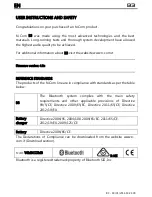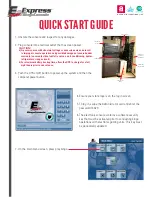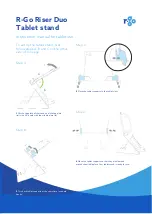
• Reference Waveform
VEHICLE INFORMATIONS
YEAR
: 1994
MAKE
: Ford
MODEL
: Explorer
ENGINE
: 4.0 L
FUELSYS : Multiport Fuel Injection
PCM_PIN : 10 Coil A YelBlk at ignition
STATUS
: KOER (Key On Running)
RPM
: Idle
ENG_TMP : Operating Temperature
VACUUM : 19.5 In. Hg
MILEAGE : 40045
• Troubleshooting Tips
Look for t he drop in t he waveform where the ignition coil begins charging to stay relat ively consist ent, which
indicates consistent dwell and timing accuracy of individual cylinder.
Look for a relatively consistent height on the “arc-over” voltage or firing line. A line that is too high indicates high
resistance in the ignition secondary due to an open or bad spark plug wire or a large spark gap. A line that is too
short indicates lower (than normal) resistance in the ignition secondary due to fouled, cracked, or arcing spark plug
wire, etc.
Look for the spark or burn voltage to remain fairly consistent. This can be an indicator of air-fuel ratio in the cylinder.
If the mixture is too lean, the burn voltage may be higher, and if too rich, the voltage may be lower than normal.
Look for the burn line to be fairly clean without a lot of hash, which can indicate an ignition misfire in the cylinder due
to over-advanced ignition timing, bad injector, fouled spark plug or other causes. Longer burn lines (over 2 ms) can
indicate an abnormally rich mixture and shorter burn lines (under 0.75 ms) can indicate an abnormally lean mixture.
Look for at least 2, preferably more than 3 oscillations after the burn line. This indicate a good ignition coil (a good
condenser on point-type ignitions).
DIS (Distributorless Ignition System) Secondary
• Theory of Operation
Most Distributorless Ignition systems use a waste spark method of spark distribution. Each cylinder is paired with the
cylinder opposite to it (1-4, or 3-6, or 2-5). The spark occurs simultaneously in the cylinder coming up on the
compression stroke and in the cylinder coming up on the exhaust stroke. The cylinder on the exhaust stroke requires
very little of the available energy to fire the spark plug.
The remaining energy is used as required by the cylinder on the compression stroke. The same process is repeated
when the cylinders reverse roles.
6-65
• Troubleshooting Tips
Look for the drop in t he waveform where the ignition coil begins charging t o st ay relat ively consistent, which
indicates consistent dwell and timing accuracy of individual cylinder.
Look for a relatively consistent height on the “arc-over” voltage or firing line. A line that is too high indicates high
resistance in the ignition secondary due to an open or bad spark plug wire or a large spark gap. A line that is too
short indicates lower (than normal) resistance in the ignition secondary due to fouled, cracked, or arcing spark plug
wire, etc.
Look for the spark or burn voltage to remain fairly consistent. This can be an indicator of air-fuel ratio in the cylinder.
If the mixture is too lean, the burn voltage may be higher, and if too rich, the voltage may be lower than normal.
Look for the burn line to be fairly clean without a lot of hash. A lot of hash can indicate an ignition misfire in the
cylinder due t o over-advanced ignition timing, bad inject or, fouled spark plug or other causes. Longer burn lines
(over 2 ms) can indicate an abnormally rich mixture and shorter burn lines (under 0.75 ms) can indicate an
abnormally lean mixture.
Look for at least 2, preferably more than 3 oscillations after the burn line. This indicate a good ignition coil (a good
condenser on point-type ignitions).
DIS (Distributorless Ignition System) Primary
• Theory of Operation
The DIS (or EI) primary ignition test is an effective test for locating ignition problems that relate to EI ignition coils.
The waveform is very useful because occurrences in the ignition secondary burn are induced back into the primary
through mutual induction of the primary and secondary windings. The waveform is primarily used to :
1. analyze individual cylinder dwell (coil charging time),
2. analyze ignition coil and secondary circuit performance (from the firing line),
3. locate incorrect air-fuel ratio in individual cylinders (from the burn line), and
4. locate fouled or damaged spark plugs that cause a cylinder misfire (from the burn line).
This test can be useful in det ection of problems in mechanical engine and f uel system components, as well as
ignition system components.
• Symptoms
No or hard starts, stalls, misfires, hesitation, poor fuel economy
• Test Procedure
1. Connect the CH A lead to the ignition coil primary signal (driven side) and its ground lead to the chassis GND.
2. With the key on, engine running, let the engine idle, or use the throttle to accelerate and decelerate the engine or
drive the vehicle as needed to make the driveability problem or misfire occur.
3. Make sure that the amplitude, frequency, shape and pulse width are all consistent from cylinder to cylinder. Look
for the abnormalities in the section of the waveform that corresponds to specific components.
4. If necessary, adjust the trigger level for a stable display.
6-64
The Ignition Peak voltage and Burn voltage measurements are available in this test,
but they should be corrected to account for the turns ratio of the coil windings.
MAX = 170 V
DUR = 1.59 ms
DWELL = 6.00 %
spark or burn
voltage
ignition coil begins
charging here
coil
oscillations
coil
fires
burn
line
arc-over or
ignition
voltage











































